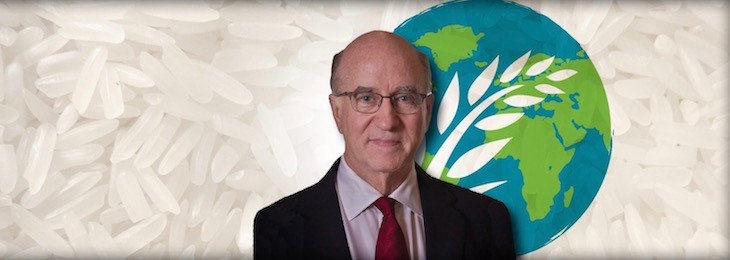Noted rice economist believes global rice prices could rebound in the coming years and benefit Arkansas farmers
by January 25, 2017 7:52 pm 508 views

Milo Hamilton, rice economist and president of Firstgrain
Rice prices have been low for many years and it has forced many rice farmers to reduce or completely stop growing the crop in Arkansas. One rice economist thinks prices could surge in the next few years because of a crisis in a country halfway around the world. He predicts prices could elevate up to three fold in the coming years.
“We’re near the turning point on rice,” economist Milo Hamilton told Talk Business & Politics. “The fact is they’re growing a lot more rice in India than they should. They’re doing it for political reasons. The bottom is going to fall out on them.”
Hamilton spoke Wednesday at the Arkansas Soil and Water Education Conference at the Convocation Center on the Arkansas State University campus. A record 370 people attended the annual conference. Many were farmers worried about the global rice markets.
Arkansas is the country’s largest rice producer, with 1.3 million acres dedicated to the crop annually. The Natural State produces about nine billion pounds of rice each year, half the amount produced in the U.S., according to the U.S. Department of Agriculture. Nearly all Arkansas rice is grown in the Mississippi Delta, and Craighead County is among the top rice growing counties in the country with about 70,000 acres.
Prices have plunged in recent years. Arkansas farmers received around $4.25 per bushel in 2016, after projections showed the farmers would get at least $4.95 a bushel. An inflated global market led by India has caused much of the problem, Hamilton said. The government in India gives rice farmers water and subsidizes diesel costs, meaning two of the largest inputs to grow the crop are being manipulated, Hamilton said. Indian farmers grow about 105 million metric tons per year, according to estimates. Famers in the country can sell their rice on the global markets for $3 bushel, and there is one ready made customer – China.
China imports up to eight million metric tons of cheap Indian rice each year, Hamilton said. The Chinese don’t import all the rice India exports, and the rest floods the global markets. India has a serious and looming problem, however. The world’s second most populous country is on the verge of a water crisis, Hamilton said. India’s water resources are dwindling, and politicians there are afraid to stop the free water subsidies to rice famers, he said. There will be a natural breaking point at which the India rice market will go into a free fall, he said.
“The problem for farmers, especially ones in Arkansas, it’s difficult to remain solvent year after year while waiting for government policies in another country to change,” he said. “But … a change is coming.”
There may already be signs that India is on the verge of agricultural paradigm shift, Hamilton said. Last year the country imported more agricultural goods than it exported, according to an analysis done by Hamilton’s company, FirstGrain, based in Austin, Texas.
A water crisis won’t just envelop India in the coming years; it will be a worldwide problem, Hamilton said. China heavily imports rice because some of its soil is tainted with toxic industrial chemicals, and its usable water supply is dwindling, Hamilton said. India and China combined are losing about 2% of their per capita water supply each year. The difference is the Chinese government knows it has a water problem, and political leaders in India don’t seem to, he said.
The U.S. has a water problem, but leaders here know it is an issue and there are many solutions available here that are not in most other parts of the world, Hamilton said. The U.S. has or controls 40% of the world’s fresh water supply. It has 60% of the world’s navigable rivers. The water table aquifers in the country are deep, especially in Arkansas, he said. The Mississippi River is an untapped water supply, he added.
Hamilton, who wrote the book “When Rice Shakes the World,” thinks the U.S. could become a major water exporter at some point. Countries like China and India will need to feed the masses and they don’t have the same kind of water access as in the U.S. A technological boom around water is likely to occur in the coming years, and it will be vital to protect the world’s food supply, Hamilton said.
The entire Western Hemisphere produces less rice than the country of Vietnam, but that could change in the next century. A person could draw a longitudinal line from southern Missouri all the way around the world, and almost all rice is grown south of that line, he said. The combination of weather and the right types of soil have made it a viable crop in many parts of the globe to the point that it’s the staple food for 3 billion people, he said. But, as the water levels shrink, rice production could shift to the water rich countries in the Western Hemisphere, such as the U.S. and Brazil.
Arkansas farmers could profit handsomely if they can hold on, Hamilton said. Low prices, floods, high input costs and other factors have led some farmers to abandon their fields in recent year, Talk Business & Politics has been told. The area’s access to water could be a boon to agriculture in the next several decades, he said.
“Underneath Arkansas is a gold mine … water. It’s all about the water,” he said.
